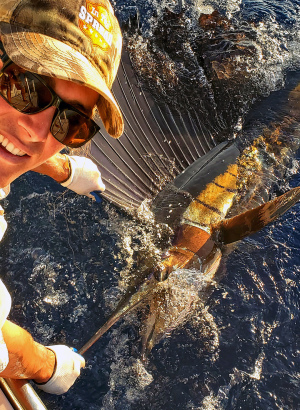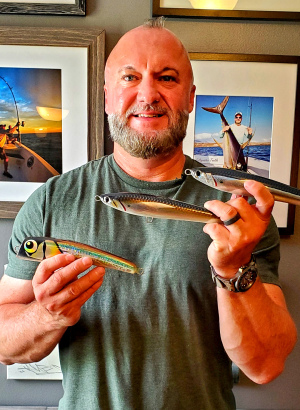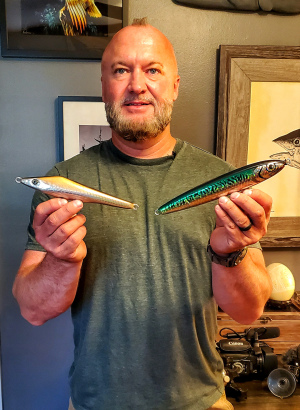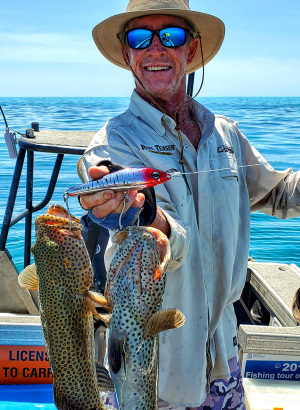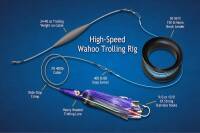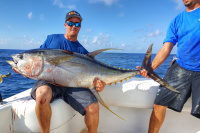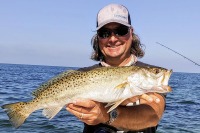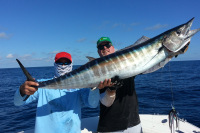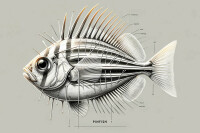Unlock the secrets of stickbait fishing for pelagic giants. Learn to choose the perfect lure, master various retrieve techniques, and handle formidable catches like yellowfin and bluefin tuna, giant trevally, kingfish, wahoo and mahi mahi.
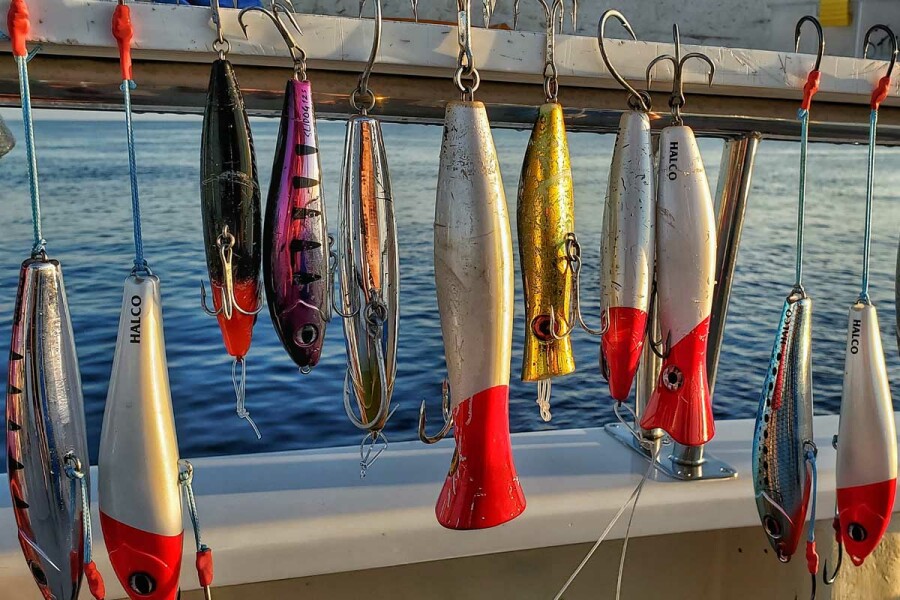
Fishing Stickbaits for Pelagic Heavyweights
Summary:
- Introduction: Embracing the excitement of stickbait fishing for pelagic heavyweights.
- Understanding Pelagic Predators: Characteristics and popular species like tuna, mahi mahi, and giant trevally.
- Stickbait Fishing: Its allure in sport fishing, targeting pelagic species.
- Lure Selection: Choosing the right stickbait for specific species and conditions.
- Retrieve Techniques: Mastering different actions for effective fishing.
- Handling Pelagic Giants: Tips for managing these powerful fish on heavy tackle.
Imagine the calm undulating motion of the oceans, as you work a stickbait just below the surface. Out of no where there is an explosion of white water and thrashing where you bait used to be. In the blink of an eye, your arms come straight, as your rod is damn near yanked from your grip. Staggering to keep your footing, line screams off your reel. Your legs, back and arms all work in unison to keep you from being pulled over the side.
Stickbait Fishing
In the fast-paced, efficiency-driven world of sport fishing, stickbaits have emerged as a game-changer. These lures are the epitome of simplicity and effectiveness, much like how the best life hacks streamline our daily routines. Stickbaits, typically slender and elongated, mimic the appearance and movement of small fish, making them irresistible to pelagic predators.
The magic of stickbaits lies in their versatility. They can be used in various ways – twitched, jerked, or retrieved smoothly – to simulate an injured or fleeing fish. This variability plays into the primal instincts of predators like Giant Trevally, Dogtooth Tuna, yellowfin and bluefin tuna or billfish, creatures hardwired to respond to the vulnerability of their prey. In essence, it's not just about the lure, but how it's presented. The angler's skill in manipulating the stickbait can turn an ordinary fishing trip into an extraordinary one, much like how adopting the right strategies can transform life's challenges into opportunities.
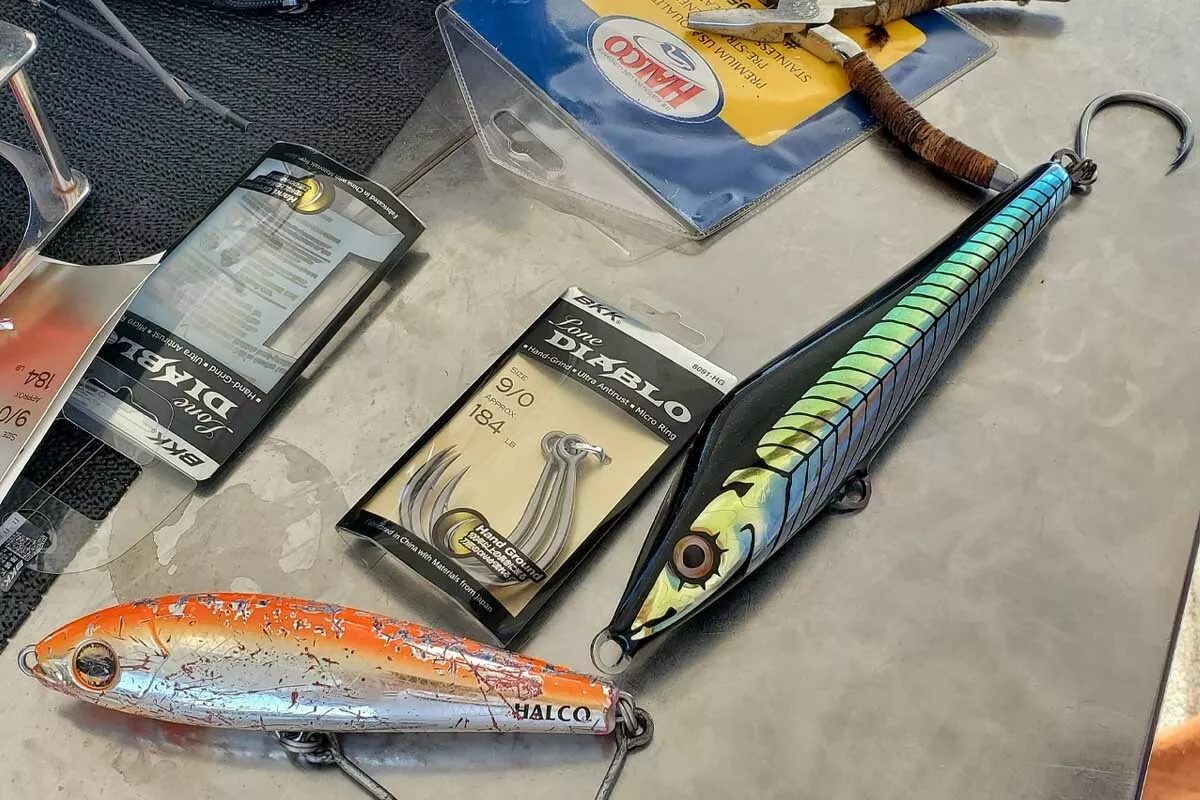
Benefits of Stickbait Fishing
Stickbait fishing offers a thrilling and diverse experience for anglers, combining excitement, versatility, and the potential for landing trophy catches.
- Exciting Topwater Action: One of the most electrifying aspects of using stickbaits is the topwater action. This technique allows anglers to witness the strike as it happens. When a predator fish attacks a stickbait on the water's surface, it creates a spectacular show of raw power and agility. The visual spectacle of a fish like a marlin or tuna leaping out of the water to snatch the lure is not only thrilling but also offers a unique insight into the behavior of these majestic creatures. It's an adrenaline rush that encapsulates the essence of sport fishing.
- Versatility for Different Species and Conditions: Stickbaits are not just about the thrill; they are incredibly versatile tools. Designed to mimic a wounded or fleeing fish, they can be tweaked and maneuvered in various ways to attract different species. This versatility is crucial, as it allows anglers to adapt their strategy to target a wide range of pelagic predators in different environmental conditions. Whether fishing in calm seas or navigating choppy waters, stickbaits can be tuned to suit the situation, increasing the chances of a successful catch.
- Potential for Trophy Catches: For those angling for a story-worthy catch, stickbaits are an excellent choice. They are particularly effective in attracting larger predatory fish, setting the stage for a potential trophy catch. The size and movement of the stickbait can be selected to target the biggest and most challenging species in the ocean. This potential to land a once-in-a-lifetime fish adds an element of excitement and challenge to fishing, making it an appealing pursuit for both seasoned and novice anglers alike.
In summary, stickbait fishing is a multifaceted approach that combines the thrill of witnessing a predator's strike, the adaptability to various fishing scenarios, and the tantalizing possibility of landing a monumental catch. It's a testament to the art and science of fishing, offering a rich and rewarding experience on the water.
Understanding Pelagic Predators
Pelagic predators are a fascinating group of fish that inhabit the pelagic zone of ocean or lake waters – an area that is neither close to the bottom nor near the shore. These fish are characterized by their life in the open water, often in the upper layers of the ocean, where they play a crucial role in the marine ecosystem.
Defining Pelagic Fish
- Open Water Habitat: Pelagic fish live in the open sea, away from the coast and ocean floor. This habitat contrasts with benthic fish that live near the seafloor and coastal fish found near shores. The pelagic zone is vast and varied, ranging from surface waters to the deep ocean.
- Migratory Nature: Many pelagic fish are migratory, traveling long distances across oceans. This migration is often linked to feeding and breeding patterns. For example, species like tuna and certain sharks undertake extensive migrations to find food or to reach spawning grounds.
- Aggressive Predators: Pelagic predators are known for their aggressive hunting strategies. They are often fast swimmers with streamlined bodies, enabling them to chase and capture their prey effectively. Examples include the great white shark, bluefin tuna, and marlin. These species are apex predators in their ecosystems, meaning they have few natural predators and play a critical role in maintaining the balance of marine life.
Pelagic fish vary greatly in size and species, ranging from small forage fish like sardines and herring to large predators. They are adapted to a life in a vast, open environment, which requires speed, endurance, and often, highly developed sensory systems to detect prey over large distances. Their life in the open waters also makes them important for commercial fishing industries, but this has led to challenges in managing and conserving these vital marine resources.
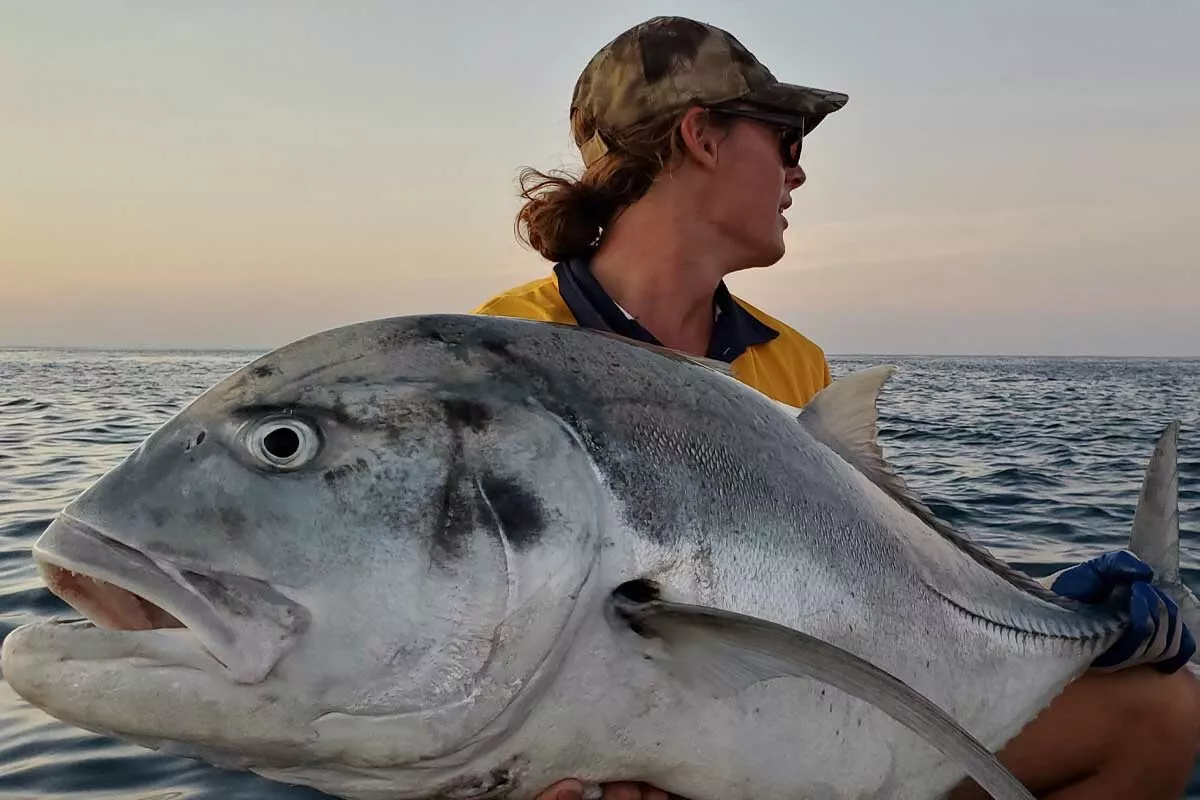
Common Pelagic Predator Targets
Pelagic predator fishing targets several popular species, each with unique characteristics and widespread distribution ranges. Here's a brief overview of some common targets:
- Giant Trevally (GT): Known for their brute strength and impressive size, GTs are a top target for sport fishers. They are predominantly found in the tropical waters of the Indo-Pacific region. These fish are renowned for their aggressive strikes and powerful fights, making them a thrilling catch.
- Dogtooth Tuna: Dogtooth Tuna, often found in the Indo-Pacific waters, are known for their elongated bodies and large, dog-like teeth. They are a challenging catch due to their deep-water habitats and formidable fighting capabilities.
- Tuna (Various Species): Tuna, including species like Bluefin, Yellowfin, and Albacore, are found in various oceans worldwide. Known for their speed and endurance, these fish are highly sought after both for sport and commercial fishing. They're remarkable for their long migrations across oceans.
- Mahi Mahi (Dolphinfish): Mahi Mahi, also known as Dolphinfish, are recognized by their dazzling colors and remarkable shape. They are commonly found in offshore temperate, tropical, and subtropical waters worldwide. Anglers prize them for their fighting ability and delicious meat.
- Wahoo: Wahoo are prized for their speed and quality of meat. They are found in tropical and subtropical seas worldwide and are recognizable by their elongated bodies and razor-sharp teeth. They are one of the fastest fish species, making them a challenging and rewarding catch.
- Sailfish: Sailfish, easily recognized by their long bill and large dorsal fin, are one of the fastest fish in the ocean. Found in both the Atlantic and Indo-Pacific oceans, they are famous for their incredible speed and aerial acrobatics. Sailfish can grow up to 100 kg (220 lbs) but are usually smaller.
- Kingfish (Various Species): Kingfish, including species like the Yellowtail Kingfish, are found in the subtropical and temperate waters of the Southern Hemisphere. They are known for their strength and speed, offering a vigorous fight to anglers.
Each of these species presents a unique challenge and requires specific techniques and strategies to catch, making them highly valued targets in the world of pelagic predator fishing. Their wide distribution ranges also mean that they can be targeted in diverse locations around the globe, adding to the allure and excitement of pelagic fishing.
Pelagic predators have evolved efficient and specialized feeding behaviors that make them formidable hunters in the open ocean. Their approach to feeding is characterized by a combination of keen senses, speed, and opportunism, often targeting schools of smaller baitfish.
Feeding Mechanisms of Pelagic Predators
- Keen Senses: These predators have highly developed sensory organs that allow them to detect prey over great distances. Their vision, sense of smell, and ability to sense vibrations in the water enable them to locate schools of baitfish even in the vastness of the open ocean.
- Speed and Agility: Pelagic predators are often incredibly fast swimmers. This speed, combined with their agility, allows them to swiftly close in on their prey, often resulting in a sudden and explosive attack.
- Opportunistic Hunting: They tend to be opportunistic feeders, capitalizing on the availability of prey. This behavior leads them to feed intensely when conditions are favorable, such as when baitfish are abundant.
Attraction to Stickbaits
- Mimicking Baitfish: Stickbaits are designed to mimic the size, shape, and movement of baitfish, which are a primary food source for many pelagic predators. The realistic swimming action of a well-designed stickbait, coupled with its visual appeal, can be almost indistinguishable from real baitfish, making it an irresistible target for these hunters.
- Triggering Aggressive Responses: The movement of stickbaits, especially when they are jerked or twitched, can simulate the erratic movements of injured or distressed baitfish. This appearance of vulnerability triggers an instinctive aggressive response from pelagic predators, who are programmed to target weak or injured prey as easy targets.
- Visual Appeal and Sound: Many stickbaits are also designed to create a disturbance on the water's surface or emit sounds that mimic those of baitfish. This additional sensory stimulus can be particularly effective in attracting predators from a distance or in murkier waters.
In essence, stickbaits tap into the fundamental feeding behaviors and instincts of pelagic predators. By mimicking the appearance and behavior of their natural prey, these lures effectively exploit the predatory tendencies of these fish, making them highly effective for anglers seeking these challenging and exciting species.
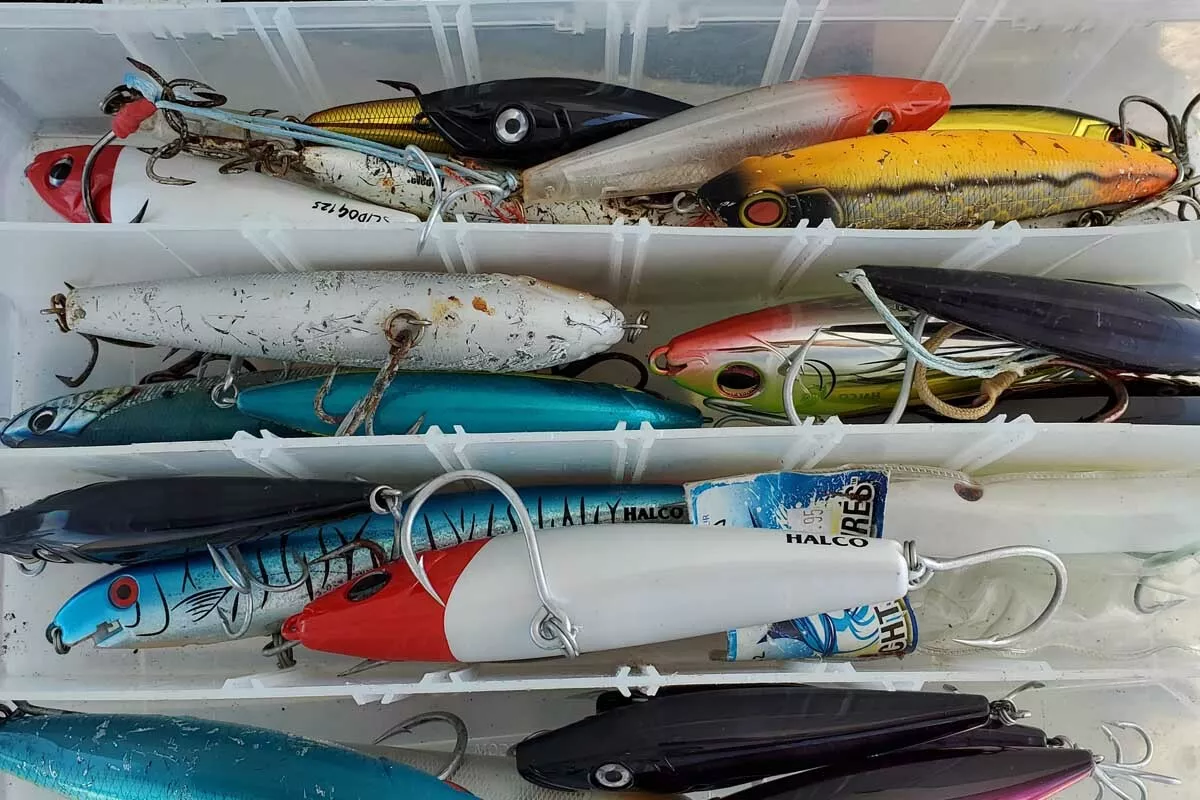
Choosing the Right Stickbait
Floating vs. Sinking Stickbaits
In the world of fishing, particularly when targeting pelagic predators, the choice between floating and sinking stickbaits can significantly impact your success. Each type has its unique advantages and disadvantages, depending on the fishing conditions and the behavior of the target species.
Floating Stickbaits:
- Pros
- Surface Action: Floating stickbaits are excellent for topwater fishing, creating visible surface disturbance and action. This is especially effective when fish are actively feeding on the surface, as the lure can mimic injured or fleeing baitfish.
- Control and Visibility: Anglers can easily control and see floating stickbaits, making them ideal for precise casts and retrievals. This visibility allows for better reaction to fish strikes and adjustments in technique.
- Less Snagging: Since they float, these stickbaits are less likely to snag on underwater structures, making them suitable for fishing over reefs, rocks, or in shallow waters.
- Cons
- Limited in Deep Water: Floating stickbaits are less effective in deeper waters or when fish are holding lower in the water column.
- Affected by Wind and Current: They can be more challenging to use in windy conditions or strong currents, as they may drift off-target or not present as naturally.
Sinking Stickbaits:
- Pros
- Subsurface Targeting: Sinking stickbaits are ideal for reaching fish that are deeper in the water column. They allow anglers to target predators that are not actively feeding on the surface.
- Versatility in Retrieval: These lures can be worked at varying depths and speeds, making them versatile for different conditions and species.
- Better in Rough Conditions: Sinking stickbaits are less affected by wind and surface chop, allowing for more stable and controlled presentations in rough water conditions.
- Cons
- Risk of Snagging: There's a higher chance of snagging the bottom or underwater structures, especially in rocky or reef areas.
- Less Visual Fishing: Anglers lose the visual excitement of topwater strikes and may have a harder time detecting bites or following the lure’s movement.
In summary, the choice between floating and sinking stickbaits depends on factors like the depth at which fish are feeding, water conditions, and the type of action desired. Floating stickbaits excel in topwater scenarios and are great for visual and exciting fishing, while sinking stickbaits offer versatility in deeper waters and less ideal surface conditions. The savvy angler often carries both types to adapt to the changing moods and patterns of pelagic predators.
Size and Weight
The principle of matching the size and weight of your stickbait to the target species and prevailing conditions is a cornerstone in effective angling, especially when pursuing pelagic predators. This approach is grounded in the idea of “matching the hatch,” meaning that your lure should closely resemble the natural prey of the fish you are targeting in terms of size, weight, and sometimes even color and behavior. Let's expand on this:
Target Species Considerations:
- Larger Predators (e.g., Tuna): When targeting larger species like tuna, it's generally beneficial to use larger stickbaits. These species are often looking for a substantial meal, and a bigger lure can present a more tempting target. For instance, a big Bluefin tuna is more likely to strike at a larger stickbait that mimics the size of the mackerel or herring they feed on.
- Smaller or More Agile Predators (e.g., Dorado/Mahi Mahi): Smaller species or those known for their agility, like Dorado, may be more enticed by smaller, more agile stickbaits. These lures can more accurately mimic the size and movement of the smaller baitfish these species typically prey upon, like flying fish or small squid.
Weight and Casting Distance:
- Heavier stickbaits allow for longer casting distances, which can be crucial in situations where fish are skittish or the boat cannot get close enough. This is particularly important in windy conditions or when fishing in large open waters where covering more area increases the chances of encountering fish.
- Conversely, lighter stickbaits may provide a more delicate and realistic presentation, especially in calmer conditions or clear waters where fish might be more wary and able to closely inspect the lure.
Depth and Water Conditions:
- In choppy or windy conditions, a heavier stickbait can be advantageous as it remains stable and maintains the desired action. It can also be beneficial when fishing in deeper waters where getting the lure down to the right depth quickly is important.
- In contrast, in shallow or very clear water, a lighter and perhaps floating stickbait might be more effective. It can be worked slowly and meticulously to entice bites without spooking the fish.
Angler's Equipment and Style:
- The choice of size and weight also needs to complement the angler's equipment. Heavier lures require stronger rods and heavier lines, while lighter stickbaits can be used with lighter, more sensitive gear, allowing for a more finesse approach.
- The angler's personal style and preference also play a role. Some anglers might prefer the challenge of using smaller lures, even for larger species, relying more on technique and presentation.
In summary, selecting the right size and weight of a stickbait is a multifaceted decision that depends on the target species, prevailing water conditions, and the angler's gear and style. A well-chosen stickbait increases the likelihood of attracting the desired species and can significantly enhance the overall fishing experience.
Action and Design
Different stickbait actions are designed to mimic various behaviors of prey fish, each appealing to the predatory instincts of different species in unique ways. Understanding and effectively using these actions can significantly enhance an angler's success. Here's a breakdown of some common stickbait actions and how they appeal to predators:
Walk-the-Dog:
- Action: This surface action involves a side-to-side motion, achieved by twitching the rod tip and reeling in slack line. The stickbait zigzags across the water's surface, mimicking a wounded or disoriented baitfish.
- Appeal to Predators: This action is visually stimulating and creates surface disturbance, which can attract predators from a distance. The erratic movement triggers an instinctive attack response, especially from species known for aggressive surface feeding, like Giant Trevally or Bass.
Erratic Darting:
- Action: Erratic darting involves quick, sharp jerks of the rod, causing the stickbait to dart side to side and up and down, imitating an injured or fleeing baitfish. The movement can be unpredictable, with sudden changes in direction.
- Appeal to Predators: This action exploits the predatory trigger of chasing down weak or fleeing prey. The unpredictable movement can provoke strikes from predators like Tuna or Kingfish, who are attracted to the vulnerability of the "prey".
Sinking with Wobble:
- Action: Some stickbaits are designed to sink when not being retrieved. As they descend, they wobble or flutter, resembling a dying or injured fish. The speed of the sink can often be adjusted by the weight of the lure and the line tension.
- Appeal to Predators: This action targets predators that are not actively feeding at the surface. The wobble during the sink mimics a natural and vulnerable movement, enticing predators like Snapper or Grouper that are looking for an easy meal.
Each action type targets a different aspect of predatory behavior:
- The walk-the-dog technique is excellent for aggressive, surface-feeding fish and clear conditions where visual cues are paramount.
- Erratic darting is effective in a range of scenarios, especially when fish are actively feeding or in clearer waters where the lifelike action of the lure can be seen.
- Sinking with wobble is particularly useful in deeper waters, murkier conditions, or when fish are less active at the surface.
By mastering these different stickbait actions, anglers can adapt to the feeding behavior of their target species under various conditions, significantly increasing their chances of a successful catch.
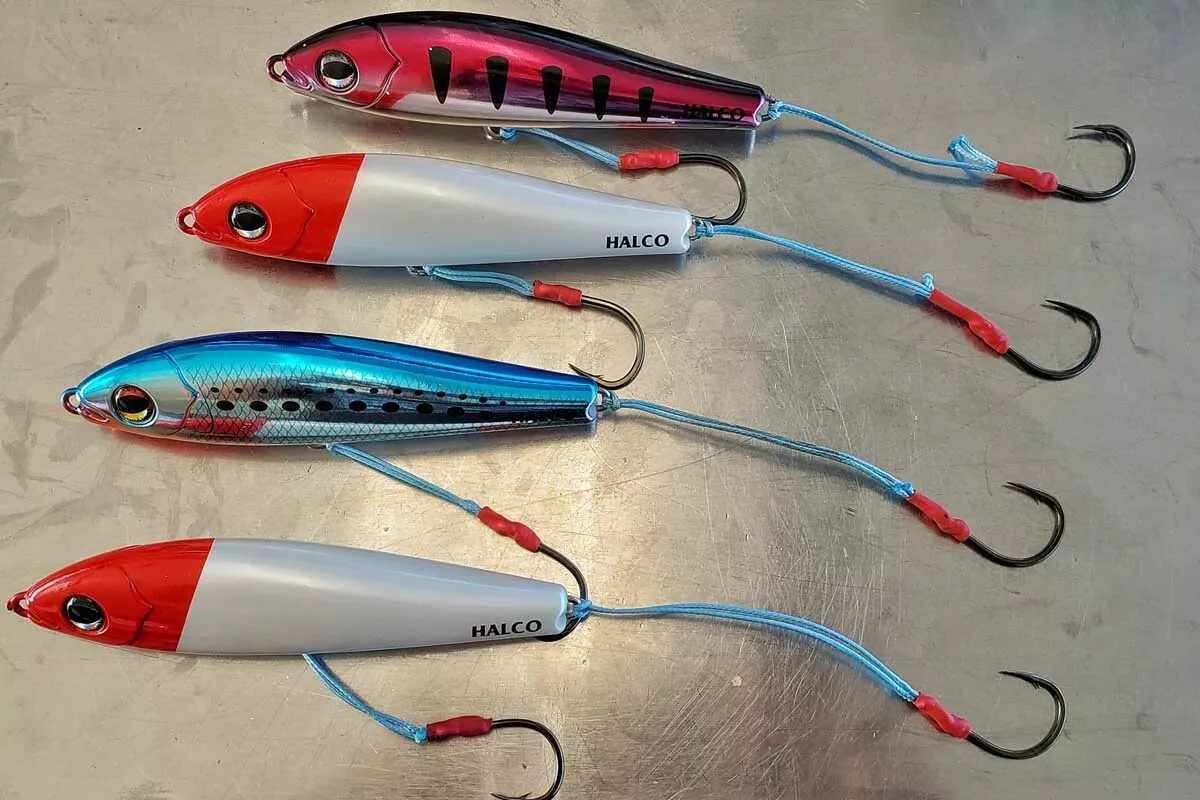
Color and Patterns
Choosing the right color for a fishing lure, particularly when it comes to stickbaits, is a critical aspect of successful angling, especially when targeting discerning pelagic predators. The primary reason for this is the concept of "matching the hatch," which means selecting a lure color that closely resembles the local baitfish or natural prey in the area you're fishing. This strategy is rooted in the feeding behaviors of predatory fish and has several important aspects:
- Mimicking Natural Prey: Predatory fish are often highly attuned to the specific types of prey available in their environment. By using a lure that mimics the coloration of these natural prey items, you increase the chances that a predator will recognize and strike at the lure. In clear water conditions, the visual acuity of fish is heightened, making the accurate representation of prey species in terms of color and pattern even more crucial.
- Environmental Adaptation: Baitfish and other prey species often have colorations and patterns that help them blend into their surroundings. By matching your lure to these colors, you’re not only imitating the prey but also ensuring that your lure fits into the visual environment of the target species. For instance, in a reef environment, lures that mimic the bright colors of tropical fish might be more effective, whereas, in open ocean waters, shades of blue, silver, or grey that resemble pelagic fish like mackerel or sardines could be more appropriate.
- Seasonal and Geographical Variations: The types of prey available to predators can vary with seasons and geographical locations. It’s important to research and understand what types of baitfish or prey are prevalent in the area during the time of your fishing trip. Local knowledge can be invaluable here. Consulting with local anglers or bait shops about what types of baitfish are currently being preyed upon can guide you in choosing the most effective lure colors.
- Behavioral Triggers: Certain colors can trigger specific behaviors in fish. For example, reds and oranges might mimic injured fish, which can incite an opportunistic feeding response. Bright and contrasting colors can be effective in murky waters or low-light conditions, as they stand out more prominently against a subdued background.
- Experimentation and Flexibility: While matching the local baitfish is a solid starting point, sometimes experimentation can yield surprising results. Fish can be unpredictable, and on any given day, they might respond differently to various colors. Having a variety of colors in your tackle box allows for flexibility and the ability to adapt to the preferences of the fish on that particular day or in specific conditions.
In conclusion, the choice of lure color is not just a matter of personal preference but a strategic decision that can significantly affect your success rate in fishing. By choosing colors that closely mimic local baitfish or natural prey, you align your strategy with the feeding instincts of the target species, thereby increasing the likelihood of attracting and catching them.
Mastering Stickbait Fishing Techniques
Casting
Long, accurate casting is a critical skill in fishing, especially when targeting pelagic predators, and it can often be the difference between a successful outing and a frustrating one. The importance of this ability is underscored in several key aspects:
- Reaching Feeding Zones: Pelagic predators, such as tuna or marlin, often feed at or near the surface, but they can be skittish and maintain a distance from boats or shorelines. Long casts enable anglers to reach these feeding zones without disturbing the fish. In situations where fish are chasing baitfish, they can move rapidly and unpredictably. Being able to cast long distances increases the likelihood of placing the lure within the strike zone.
- Stealth and Minimizing Disturbance: Pelagic species are often highly sensitive to noise and disturbances. A boat getting too close can spook the fish, causing them to dive deeper or leave the area. Long casting allows anglers to stay at a respectful distance while still targeting the fish effectively. The ability to cast accurately is equally important. It ensures that the lure lands precisely in the desired location, whether that’s near a school of baitfish, beside a floating structure, or in a specific current line where fish are actively feeding.
- Maximizing Lure Performance: Many stickbaits and other lures used for pelagic fishing are designed to perform a specific action when retrieved. Longer casts allow more time for the lure to 'work' in the water, giving it a chance to mimic the movement of natural prey effectively. The longer the lure is in the target zone, the higher the probability of attracting and provoking a strike from a predator.
- Covering More Water: Long casts allow anglers to cover a greater area of water, increasing the chances of encountering fish. This is particularly important in vast open-water environments where fish may be spread out. Covering more water is also beneficial when searching for fish or when the exact location of the fish is unknown.
- Adapting to Environmental Conditions: In windy conditions or when dealing with strong currents, the ability to cast long distances becomes even more crucial. It compensates for drift and helps maintain control over the lure’s placement and movement.
- Enhancing Angler Experience: Mastery of long, accurate casting can significantly improve the overall fishing experience. It adds to the angler’s sense of achievement and increases the excitement and anticipation of a potential catch.
In conclusion, long and accurate casting is a vital skill in the arsenal of any angler pursuing pelagic predators. It enables effective targeting of fish while respecting their natural behavior and habitat, ultimately leading to more successful and fulfilling fishing experiences.
Retrieving
Different types of stickbaits require varied retrieve techniques to create lifelike action in the water, effectively mimicking the movement of natural prey and triggering strikes from predatory fish. Here's a guide on how to retrieve different stickbait types:
Floating Stickbaits:
- Walk-the-Dog: This is a classic technique for floating stickbaits. Use a series of rhythmic twitches with your rod tip while retrieving slack line. This creates a side-to-side motion on the surface, resembling a wounded baitfish.
- Steady Retrieve: A simple and steady retrieve can also be effective, especially in calmer waters. It creates a consistent, subtle wake that can entice curious predators.
- Pause-and-Go: Intermittently pausing during the retrieve can trigger strikes, as predators often attack when the baitfish appears to be stopping or slowing down, indicating vulnerability.
Sinking Stickbaits:
- Sweep-and-Pause: After casting, let the lure sink to the desired depth, then use a sweeping motion with the rod to move the lure, followed by a pause. The sinking phase mimics a dying fish, and the sweep mimics an escaping motion.
- Jerk and Twitch: Sharp jerks and twitches with a pause can create an erratic action, imitating an injured fish trying to escape. This method often triggers aggressive strikes.
- Slow Retrieve: A slow, steady retrieve at varying depths can be effective, especially in deeper waters or when fish are less active. This technique requires patience and a keen sense of timing to detect subtle bites.
Suspending Stickbaits:
- Stop-and-Go: Cast and retrieve with a series of starts and stops. The lure suspends in the water column during the stops, which can provoke strikes from predators watching the bait.
- Twitch-and-Pause: Similar to the jerk and twitch technique, but with more emphasis on the pause. This allows the stickbait to suspend and mimic a stunned or injured baitfish.
Poppers (Topwater Stickbaits):
- Popping Action: Use a sharp tug to create a loud splash and bubble trail, mimicking a fleeing or distressed baitfish on the surface. This is great for attracting fish from a distance.
- Varied Retrieval: Mixing fast and slow retrieves, along with pauses, can be effective. The unpredictable movement can trigger strikes from aggressive surface feeders.
General Tips for Creating Lifelike Action:
- Match the Speed to Conditions: Adjust your retrieve speed according to the activity level of the fish. More active fish may respond to faster retrieves, while slower retrieves can be effective for less active fish.
- Observe Natural Prey: Try to mimic the movement of the local baitfish. This might involve varying your retrieval technique based on your observations.
- Stay Alert and Responsive: Be ready to adjust your technique based on the fish's response. Sometimes, a slight alteration in speed or rhythm can make a big difference.\
- Practice and Experimentation: Each body of water and fish species may require a slightly different approach. Don't hesitate to experiment with different techniques until you find what works best in your specific situation.
By mastering these techniques and understanding how to create lifelike action with your stickbaits, you can significantly increase your chances of attracting and catching pelagic predators.
Fighting the Fish
- Match the Speed to Conditions: Adjust your retrieve speed according to the activity level of the fish. More active fish may respond to faster retrieves, while slower retrieves can be effective for less active fish.
- Observe Natural Prey: Try to mimic the movement of the local baitfish. This might involve varying your retrieval technique based on your observations.
- Stay Alert and Responsive: Be ready to adjust your technique based on the fish's response. Sometimes, a slight alteration in speed or rhythm can make a big difference.
- Practice and Experimentation: Each body of water and fish species may require a slightly different approach. Don't hesitate to experiment with different techniques until you find what works best in your specific situation.
By mastering these techniques and understanding how to create lifelike action with your stickbaits, you can significantly increase your chances of attracting and catching pelagic predators.
Fighting the Fish
Handling powerful pelagic predators on heavy-duty spinning tackle is a challenging yet thrilling aspect of sportfishing. These species are known for their strength, speed, and endurance, so proper technique and equipment are crucial. Here are some tips to effectively manage these formidable fish:
Use Quality Tackle:
- Rod and Reel: Choose a heavy-duty spinning rod and reel designed for big game fishing. The rod should have enough backbone to handle the strength of pelagic predators, and the reel should have a robust, smooth drag system to withstand long, powerful runs.
- Line: Use a high-quality braided line for its superior strength-to-diameter ratio and minimal stretch. This provides better sensitivity and control during the fight.
Set the Drag Properly:
- The drag should be set correctly before you start fishing. A general rule is to set the drag at about one-third of the line's breaking strength.
- Use a scale to set the drag accurately if possible. This precision ensures you have enough tension to hook the fish firmly but not so much that the line breaks on a powerful run.
Fighting the Fish:
- Pump and Wind Technique: Use the "pump and wind" technique – lift the rod smoothly to apply pressure on the fish, then reel down as you lower the rod, recovering line. This method helps tire the fish efficiently.
- Rod Positioning: Keep the rod at an aggressive angle, at all times, to maintain steady pressure. Don't lift the rod much past 45-degrees without really knowing the limitations of your rod. This is referred to as high-sticking (raising the rod too high), which can break the rod or line.
- Use the Reel, Not the Rod: Fight the fish with the reel, not by pulling with the rod. Use the drag system to your advantage to wear down the fish.
Manage Line Pressure:
- Be constantly aware of the line tension. If the fish surges, be prepared to let it run, using the drag to control the line going out.
- Avoid slack in the line, which can lead to a lost hook-up. Keep the line tight but not overly strained.
Positioning and Boat Handling:
- If fishing from a boat, use the boat to your advantage. The captain can maneuver the boat to help keep the line angle favorable and reduce the distance to the fish.
- Stay aware of the fish's position to avoid line tangles with the boat and other obstacles.
Endurance and Patience:
- Fighting a large pelagic predator can be a long and exhausting process. Stay patient, and keep your focus on maintaining proper technique.
- Stay hydrated and switch off with another angler if needed, especially during extended fights.
Safety First:
- When landing the fish, be cautious. Large pelagic species can be dangerous due to their size, strength, and sharp teeth.
- Use appropriate tools like gaffs or nets, and ensure everyone on the boat knows their role in the landing process.
Remember, every species and situation is different, so flexibility and adaptability are key. Learning to read the behavior of the fish during the fight and adjusting your tactics accordingly is a skill that develops with experience.
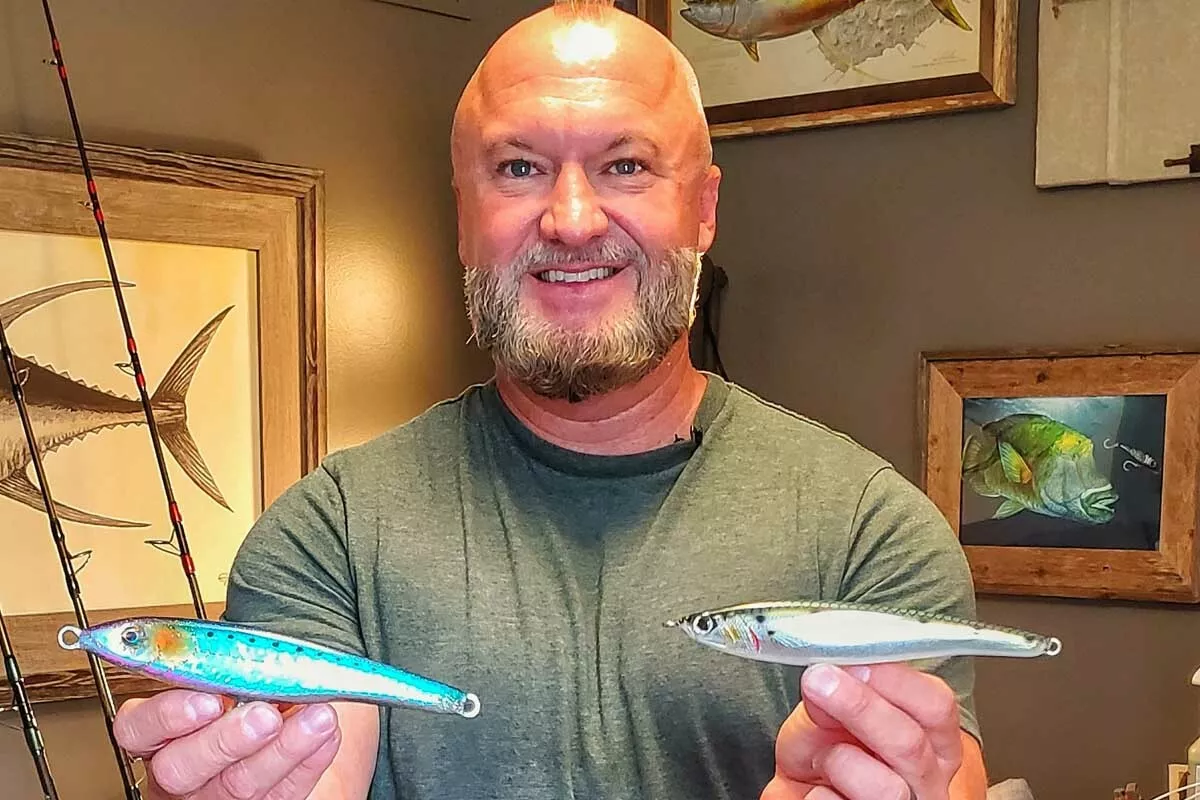
Pro Tips for Success
Successful stickbait fishing, especially for elusive pelagic predators, often hinges on an angler's ability to understand and respond to the environment. Here's an expanded look at some pro tips for success:
Read the Water:
- Look for Wildlife Cues: Birds diving into the water can indicate schools of baitfish, which in turn attract predators. Watching and following bird activity can lead you directly to feeding fish.
- Baitfish Activity: Pay attention to baitfish behavior. If you see schools of baitfish jumping or moving erratically, it's likely they are being chased by predators. Surface disruptions, especially in calm water, can also be a telltale sign of predatory activity.
- Water Conditions: Notice the color and temperature of the water. Predators often prefer clear, warmer waters. Look for edges where different water currents meet, as these areas can concentrate baitfish and attract predators.
Time Your Casts:
- Dawn and Dusk: These times are known as the “golden hours” in fishing. Predators are more active during these periods as the low light levels allow them to hunt more effectively.
- Tides and Moon Phases: Understanding how tides affect fish behavior in your specific fishing area can greatly increase your chances. Full and new moon phases can also influence fish activity.
Vary Your Retrieve:
- Speed: Altering the speed of your retrieve can make a big difference. Some predators prefer a fast-moving target, while others may be enticed by a slower, more erratic retrieve.
- Action: Mix up your stickbait’s action with jerks, twitches, pauses, and steady retrieves. Observing how fish react to different movements can guide you to the most effective technique for the day.
- Depth: Especially with sinking or suspending stickbaits, experiment with retrieving at different depths, as predators may not always feed at the same water level.
Be Patient:
- Persistence: Stickbait fishing can require a lot of trial and error, and success might not come immediately. Patience is essential; keep trying different areas, techniques, and lures.
- Stay Observant: Even when the fish aren’t biting, there’s a lot to learn. Observe the environment, the baitfish, and any predator activity. This knowledge builds over time and can lead to better future outings.
- Adaptation: Be willing to adapt your strategy. If something isn’t working, don’t hesitate to change your approach. Flexibility is often the key to a successful fishing trip.
By integrating these pro tips into your fishing strategy, you increase your odds of success. Stickbait fishing for pelagic predators is as much about understanding the environment and the behavior of the fish as it is about the actual technique. Combining skill, knowledge, and patience will make you a more effective angler.
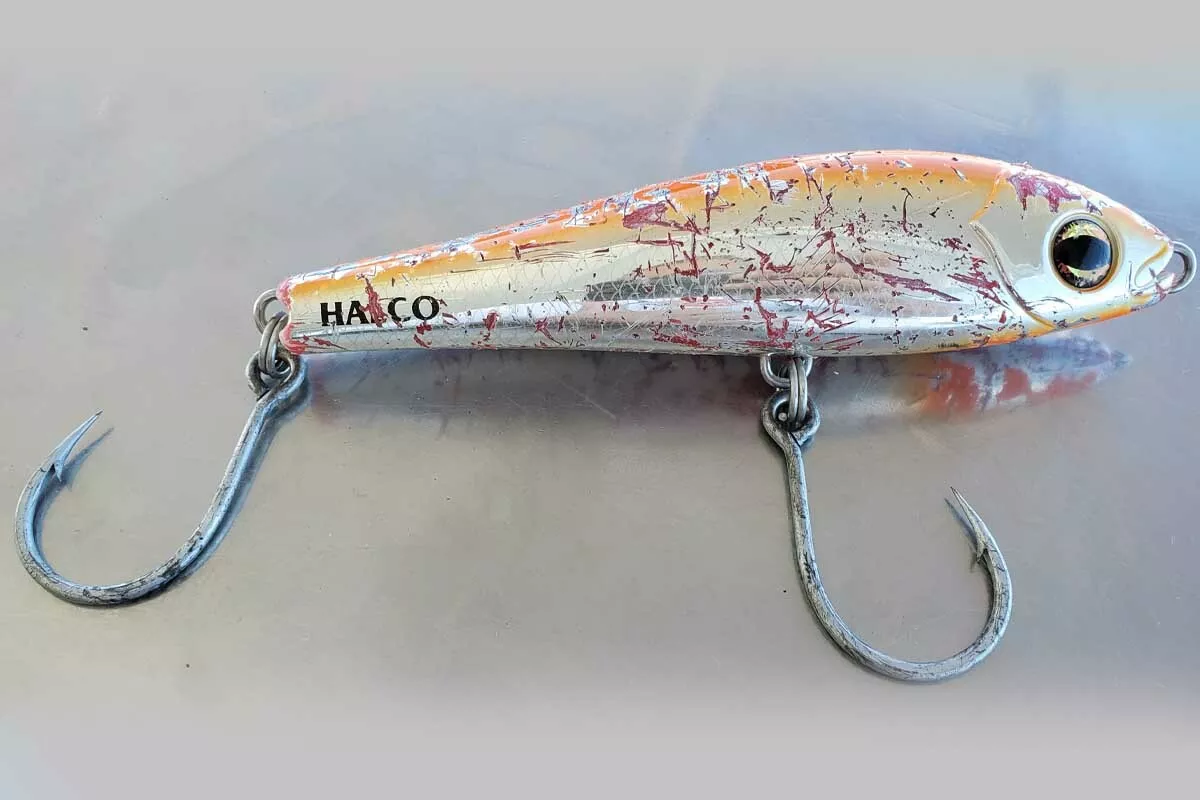
Conclusion
In the realm of sport fishing, the pursuit of pelagic predators with stickbaits is a tale of excitement, strategy, and connection with nature. This style of fishing, while challenging, offers a range of benefits that enthrall and reward the dedicated angler.
Imagine the early hours of dawn, the ocean a vast expanse of possibilities. The sun, barely peeking over the horizon, casts a golden hue across the water. This is the prime time for stickbait fishing, a method steeped in both art and science, designed to outwit the ocean's most formidable hunters.
The first and most exhilarating advantage of stickbait fishing is the intense topwater action it often elicits. The sight of a massive tuna or a majestic marlin exploding out of the water in pursuit of a well-placed lure is a spectacle that resonates with the primal core of any angler. This visual drama is not just about the catch; it’s a display of nature’s raw power, a moment where man and the wild meet.
Versatility is another hallmark of stickbait fishing. The vast open waters are home to a diverse array of predators – each with its unique habits and preferences. Stickbaits, with their varied sizes, colors, and actions, can be adapted to target a wide range of species, from the agile mahi-mahi to the mighty kingfish. This adaptability is crucial, as it allows anglers to respond to different conditions and behaviors, making the most of their time on the water.
Then, there's the potential for trophy catches. The oceans are home to some of the most sought-after species in the angling world. The challenge of landing a trophy fish is what drives many to the sport, and stickbaits, with their lifelike action and appeal, are often the key to enticing these elusive giants. The thrill of battling a large predator, feeling the power at the end of the line, and the strategy involved in landing such a fish is the pinnacle of fishing achievements.
In this narrative, the angler is both a participant and a storyteller, weaving tales of challenges faced and victories won. The benefits of stickbait fishing extend beyond the physical catch; they encompass the lessons learned, the moments of awe, and the deep connection with the marine world. It is this rich tapestry of experiences that makes stickbait fishing for pelagic predators an enduring and captivating chapter in the story of angling.
Seth Horne
In The Spread, Chief Creator
Login
to leave a review.
User Reviews
There are no reviews yet.Complete Dredge Pulley Setup Guide
Saltwater
12.28.2020
High Speed Wahoo Trolling Rig
Saltwater
09.07.2018
Best Bait for Wahoo
Saltwater
12.30.2023
Pinfish - A Comprehensive Guide
Saltwater
11.10.2023
0

